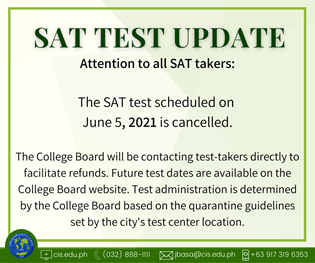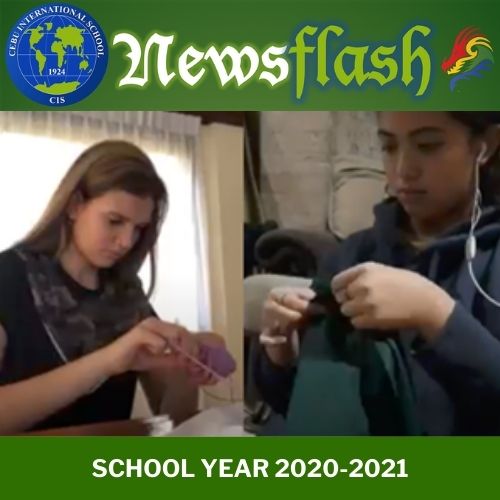
Virtual Summer Programs
We invite you to join the Virtual Summer Programs hosted by Cebu International School! This is open to everyone, so go and tell your friends and family!
For full list of programs and fees, please visit this link https://bit.ly/Summer2021CIS
To sign up for the programs, visit https://bit.ly/Summer2021CISJoin
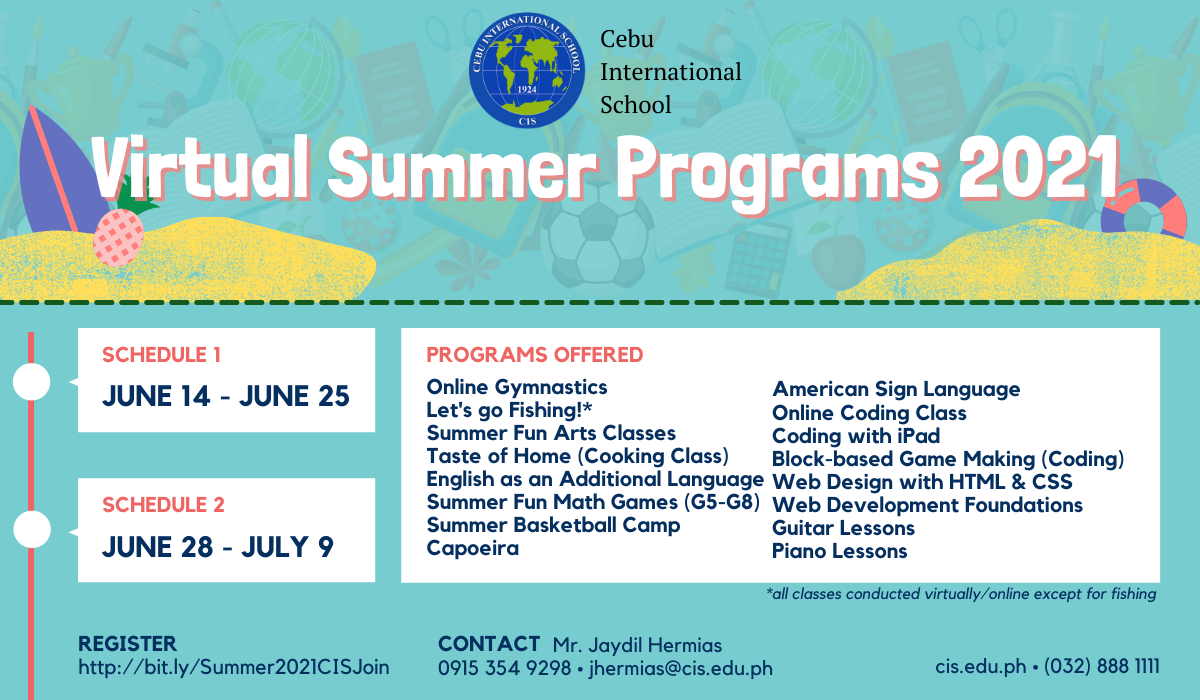
Elementary News
by Mr. Glenn Davies, Elementary School Principal
Dear Elementary Community,
As we move toward the end of the month of May, CIS will hold the annual Celebration of Learning event where students will take the opportunity to demonstrate their personal growth. As an IB PYP school, CIS measures student growth in a range of ways because we recognize that students who are learning to navigate a rapidly changing world need to master a wide range of skills and competencies. Traditional schooling places great importance on excellent grades, high test scores and the rapid recall of knowledge. However we all know that a high test score is a poor predictor of life success. Rather, measuring students’ success against a wide range of skills and competencies is a more accurate way of determining growth and improvement over time. In an IB PYP school we measure growth by observing the nature of students’ inquiry over time, by observing for depth and breadth of their ability to self manage the learning process. We measure students’ awareness of authentic challenges that require solutions based on the integration of knowledge that spans and connects across different subjects. We do assess their subject knowledge, but also how students apply their conceptual understandings to further their own investigations successfully. We are deeply concerned with how students demonstrate and develop the approaches to learning skills and attributes and how students demonstrate both independence and an ability to learn collaboratively.
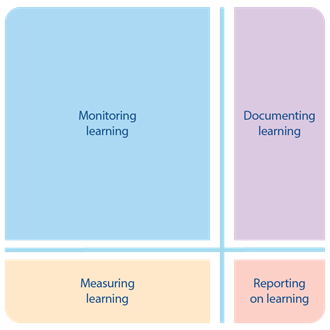 CIS teachers employ 4 types of monitoring process to measure student growth. The most valuable tool is our daily formative assessment practices where learning progress is monitored daily in a partner relationship between students and teachers. As students who have agency (a sense of ownership over their learning), daily negotiation takes place between the teacher and the student. The teacher provides the student worth feedback regarding their learning, and students equally seek advice as they engage in productive struggle to grasp new knowledge, concepts and skills. As this relationship between the teacher and student matures, the teachers and students form a learning partnership. Our CIS celebration of learning, held on Wednesday 26th May, is an opportunity for our students to demonstrate how this learning partnership has equipped them to be self directed learners who make meaningful decisions about the direction of their learning. We ask that you highlight the Celebration of learning date on your calendars so you can be a part of this important day.
CIS teachers employ 4 types of monitoring process to measure student growth. The most valuable tool is our daily formative assessment practices where learning progress is monitored daily in a partner relationship between students and teachers. As students who have agency (a sense of ownership over their learning), daily negotiation takes place between the teacher and the student. The teacher provides the student worth feedback regarding their learning, and students equally seek advice as they engage in productive struggle to grasp new knowledge, concepts and skills. As this relationship between the teacher and student matures, the teachers and students form a learning partnership. Our CIS celebration of learning, held on Wednesday 26th May, is an opportunity for our students to demonstrate how this learning partnership has equipped them to be self directed learners who make meaningful decisions about the direction of their learning. We ask that you highlight the Celebration of learning date on your calendars so you can be a part of this important day.
How We Express Ourselves
Kinder and Grade 1 Tamaraws
 As we embarked on our last unit for this school year, How We Express Ourselves, we started by reading a story about a girl who manages to convey her emotions through a series of actions until she finally made herself cool off away from everyone, especially her younger sister. The students then shared their experiences on how they show their feelings toward a certain situation. Most of them said reading a book can help you cool down, drawing, painting, taking pictures and even walking your dog.
As we embarked on our last unit for this school year, How We Express Ourselves, we started by reading a story about a girl who manages to convey her emotions through a series of actions until she finally made herself cool off away from everyone, especially her younger sister. The students then shared their experiences on how they show their feelings toward a certain situation. Most of them said reading a book can help you cool down, drawing, painting, taking pictures and even walking your dog.
We carried on the second line of inquiry which is “Appreciation of the different ways people express themselves”, and focused on looking deeper into one´s art and how it varies to everyone. We showed students some of the 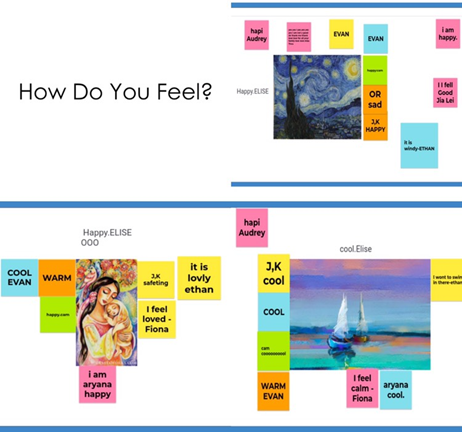 world’s famous paintings and artwork on how it makes them feel. The students discussed how the colors, strokes and subjects of the painting affects the artwork and the eye of the beholder. Then, we talked about the story How Artists Tell Different Stories and highlighted that artists are not just those who paint and do art rather they are people who express themselves responsibly and effectively through different mediums.
world’s famous paintings and artwork on how it makes them feel. The students discussed how the colors, strokes and subjects of the painting affects the artwork and the eye of the beholder. Then, we talked about the story How Artists Tell Different Stories and highlighted that artists are not just those who paint and do art rather they are people who express themselves responsibly and effectively through different mediums.
Finally, we encouraged the students to be an artist themselves and asked them to make an artwork using paper and coloring materials. They put together the things that they have learned from the different artists like Vincent Van Gogh and his style in painting but they centered their piece on how they felt at that time of the day and how they see themselves in the future.
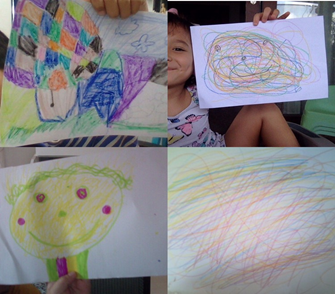
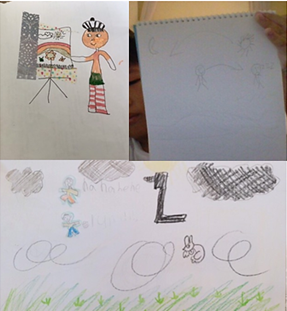
Middle and High School News
by Mr. Dale Wood, Middle & High School Principal
As we approach the end of the academic year, we also are moving toward the culminating summative assessments in our respective courses. In keeping with a bit of a philosophical shift in alignment with our transition to MYP, you will find that the majority of our end-of-year assessments are performance assessments, where students demonstrate their understanding and highlight their skills through a performance of some type, or a product/project performance where students demonstrate their knowledge and skills through creating a substantial product.
In this final month of school we continue to provide instruction for our students that helps them reach academic standards and we continue to strive to keep the classroom student-centered, as we know that the person doing the most talking is, provided that this talking is on task and relevant, doing the most thinking, and the one doing the most thinking is doing the most learning.
This week we take a look into our Design and Science classes to see how our students are thinking critically and creatively to conduct experiments and produce designs while they are at home.
Grade 8 and 9 Design Classes
by Ms. Gerri Ancajas-Jumao-as, Design Teacher
The Grade 9 Design class is currently working on their unit on Textile. They are developing their sewing and textile related skills and addressing the key concept of development by looking at processes through improvements and textile materials to create a product.
Here are some of our students’ documentation of their progress. As you can see student agency, ownership, as well as peer-feedback and collaboration play important roles in the students as they follow the design process.
Embroidery will be used in the final design because of the branches. I plan to embroider the branches on the cloth by using the satin method. Because I would have to cover a lot of length I might use yarn to do this or just stick to normal thread. I will be using this skill because I do not have a complete piece of cloth since they are all leftovers. This will be used when I put together the cloth for the base frame. I need to join my largest green clothes just to make sure I get the right and proper length. I will be using this technique in my design because I do not have the exact lengths of what I need (in this case some might be too large for the desired shape). This will also be used in the petals because not only does it shorten the length; it gives the cloth a smoother edge. – Sofia
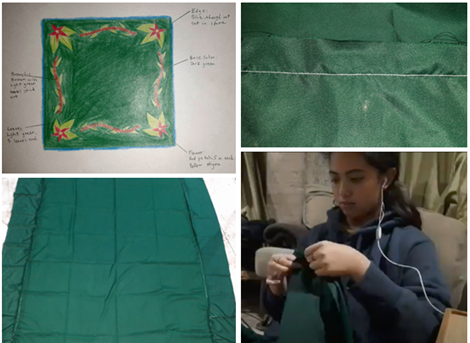
Skills that I have learned from my formative tasks that will be used for my summative are: shortening a cloth, joining two pieces of fabric, and repairing a hole. I will be using the skill of shortening a cloth just in case there is still some more space on the shirt that I didn’t use for the rug, even though the rug is done. I will be using the skill of joining two pieces of fabric when I finish using one shirt and I need to transition to another shirt, I will join the two pieces of fabric together. I will be using the repairing a hole skill just in case there is an unwanted hole on the shirt that messes up the rug. With that skill, I can cover up that hole. – Liam
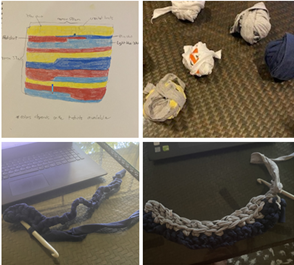
This is my final design. Reflecting the opinion in the survey group, I changed the background to clothes instead of boxes and changed the design. There is another change here: making a pot holder, not a cup holder. In the survey, my mom told me to make a pot holder, so I added a pot holder. When I make these holders, I will use running stitch back stitch and satin stitch. – Minseong
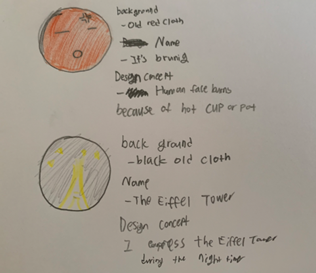
For my final design, I decided on the Table Runner, because in my survey, more people thought it would be better to have a table runner for people to see rather than a pillowcase that no one would see. Also you can use a table runner as a centerpiece and It would also be a lot easier to make considering the fabric is less. The design is also more neutral so it would match people’s houses better. I am using Cotton sheets and dish towels to make it. I will also use yarn to make tassels at the two ends of the table runner. – Sealoa
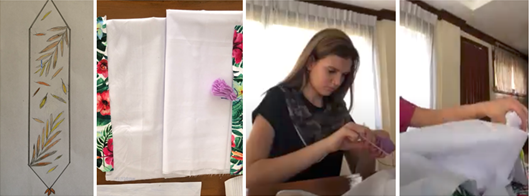
The main change to the designs is really just the top flap. Instead of having a loop at the end to close the case, the flap has a buttonhole so that it can be used to close up the case. I think the best method is what is normally used for bags; a separate piece of fabric that is attached to the back so that it can fold forward. I have 4 different fabrics that I plan to use; a bright yellow cotton one, a dark blue cotton fabric, a dark greenish blue fabric, also cotton, and a light greenish blue fabric, which is a bit silkier. Now, thinking about the textures of the fabric, I think it’s better to use the dark green-blue fabric as the inner lining instead of the lighter one, since it’s a bit stronger and made of more cotton than the lighter fabric. The yellow fabric is probably the stiffest and toughest one I have, so that is definitely what I’ll be using for the lining. The embroidery on the cover of the case will be contrasting colors, like yellow, orange, or gold. – Mahati
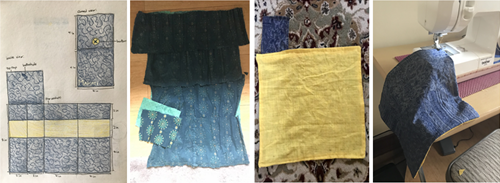
Things I learned from our formative task was obviously how to sew and the different techniques and different sewing styles to use. Another technique I learned during the formative time was embroidery- about the different designs and techniques they use while putting designs on different fabrics and sometimes even words. The last memorable thing that I learned from the formative task was weaving and that was our first task ever and to be honest it was the easiest for me to learn since it didn’t involve a needle and thread which is great for me since I’m not the best at using them. The weaving was so easy and it actually was really fun to do and I learned it to the point that I was able to do the task while watching tv which is something really rare for me to do and only if I really understand how to do something. – Natalie
We practiced lots of skills in our formative tasks, so I’ll be applying them to my final design. I’m using the tools of backstitch, hemming, and joining two pieces of fabric together. I’m also going to be using the hemming technique when sewing my pillowcase for the open end. This is a very useful technique for a pillowcase because it will be easier to cover a pillowcase because I won’t be sewing the opening together. Instead, I’ll be hemming it. I’ll be using the backstitch for sewing the outer edges of the two fabrics together because it’s an easy and reliable stitch to use and it holds the fabric together well. I’ll also be joining two pieces of fabric together because one piece of fabric will be on the front of the pillowcase, and I’ll sew that together with the plain white piece of fabric that will be shown on the back of the fabric. – Esther
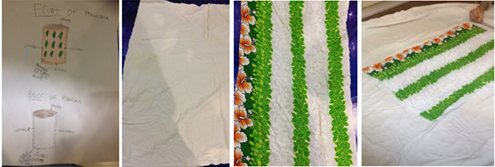
The final design chosen is a denim jacket with minimal embroidery in exchange for a simple and utilitarian look. There is an embroidered piece on the right breast of the apron. Cutting open the legs of the old jeans makes it easier to source long and wide planes of material, and preserving the waist area with the pockets is easy enough to do. There are also a lot of seams already sown in, meaning less edges that need to be smoothed down. The things I will be applying the most to this project are the skills of embroidery, joining cloth, and adding seams. These are especially important as denim is not only thick, but also very rough around the edges when cut, and the wide expanse of blue may throw off a lot of people. The embroidery might be harder to do, and the motif might not stay the same depending on what colors I have, but really this design hasn’t changed from when it first was made, to when it was shared in a survey, and now when it’s on the final leg of the summative. – Zeke
The Grade 8 Design class started their unit on Upcycling. They are developing their recycling and upcycling related skills and addressing the key concept of development by looking at processes through improvements and recycled materials to create a product.
Here are some students’ documentation of their progress.
My initial struggle creating my product was that my paintbrushes weren’t really working so I decided to just use my finger because I could smooth it out and it would be even and not clumpy. Some skills I am developing are painting skills and open-minded skills because of what I did to solve my problem. I think after doing several formative tasks it was easier for me because we had done things like this before and I think it helped me in making my summative one. – Avery
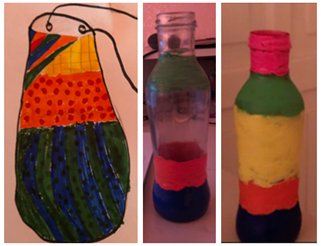
I think one of the initial struggles I had making this was the time aspect, it took much longer since it took about 30 mins to stick the scrabble pieces together and form one coaster, which means I spent extra time apart from class time to work on it. I think that because we did multiple crafty formatives beforehand it helped get more crafty and I think I would’ve worked slower without the previous formative projects. – Miguel
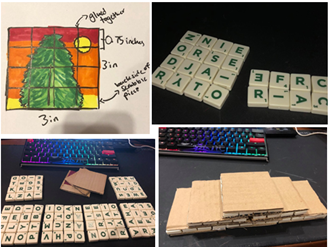
This product will be made out of wood. It will have screws sticking out of it acting like hooks. It is like a wall itself so that you can just hang items on it and so you don’t have to drill the wall. I think having enough time might be my struggle because it took a lot of time to take nails out. Not having all the tools that I need is another challenge. Rounding the corners was also challenging and I addressed it by putting a lot of effort and time into making it round. – Caleb

Creating the product was much easier during the session and much more realistic after doing several formatives because I have more experience and I have a clear vision on what I will have to do in the future. I also have received multiple feedback from my teacher for me to understand what I had to improvise in detail, which was also a factor that contributed to my performance this session. – Roland

I think it was kind of easier because of the formatives we had beforehand. The formatives helped me prepare for making something kind of complicated. The things I had to do were kind of simple like cutting and glueing but the base of the lamp I had to improvise. Since it will be difficult if I actually used the base of a lamp then how will I attach the lamp shade. – Aaryan
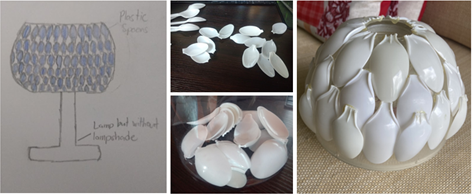
This project is helping me develop my innovative and creative thinking skills. I was able to make necessary changes to the upcycling process of my product, and I came up with a more convenient way to go about the steps I had trouble with. Having done several upcycling projects before and doing research prior to that have made the creation of my products easier. Since we continuously did those for many sessions, I’ve gotten more familiar with the entire process in terms of the preparation, planning, and the necessary descriptions of my required materials and their purposes. With that said, I feel that it won’t take a long time for me to complete this project. – Fiana

I changed the basket design, especially size and color. I changed the colors to yellow and orange. I also put in a bee and flower so it makes the basket more attractive. I made the size bigger so when someone uses it, more items are fitted inside, making it useful and comfortable. I made the basket holder by using the rest of the plastic bottle. I think the basket is practical. I think I use my creative skills while I make the basket because I create the design and shape of the basket. – Yeseul

My initial struggle when creating this product was that the top would not have a proportionate size; therefore I cut the topside of the plastic bag to tried and make it proportionate while also folding it to the inside. This product was harder than expected since my formative tasks were much easier and took less effort. In this summative, I have to use multiple coats of spray paint to make the bag look white but if the bag has any creaks on them the paint can start to fall off. This was also harder since it required more thinking and creativity to make. – Sengo

My initial struggle was to place the first tape because the paper kept falling and I had to use one hand to cut the tape and the other to stabilize the paper to the bottle. I think that my taping skills are really developing due to the amount of tape I’m using in this project. It was easier to do what I did because I had practice with cutting, sketching, and piercing. so now it took me less time to do all of the actions and I reckon it’ll get better and better with more practice. – Noam
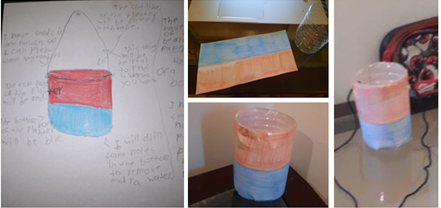
Having done several formative tasks beforehand really came in handy in creating this final product and it’s much easier now. This is because, from the formative tasks, I’ve learned ways to make my creations or products more effectively and also come up with a good design. From the formative assessments, I’ve learned to do things in a better way and also avoid certain things that may damage or ruin my product. So in conclusion, through formative assessments, I’ve learned my lesson and have applied what I’ve learned to my final product, which I’m currently in the process of making. – Gabrielle

Grade 10 Science
Grade 10 students recently did a presentation on Genetically Modified 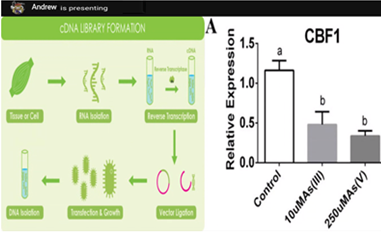 Organisms. They were provided with a range of categories, such as, Insulin production, Spider silk production, Frost resistant crops, Drought resistant crops, Flood tolerant crops, Bt crops, Herbicide resistant crops, etc. They chose a particular organism and conducted research on the techniques along with steps that are involved in the engineering and the transfer of the desired gene to the target organism. Also, they evaluated the advantages and disadvantages of GMOs. Their presentations were made using PPTs. To promote the chosen ATL skill of communication, each presentation was peer reviewed using a TAG feedback form.
Organisms. They were provided with a range of categories, such as, Insulin production, Spider silk production, Frost resistant crops, Drought resistant crops, Flood tolerant crops, Bt crops, Herbicide resistant crops, etc. They chose a particular organism and conducted research on the techniques along with steps that are involved in the engineering and the transfer of the desired gene to the target organism. Also, they evaluated the advantages and disadvantages of GMOs. Their presentations were made using PPTs. To promote the chosen ATL skill of communication, each presentation was peer reviewed using a TAG feedback form.
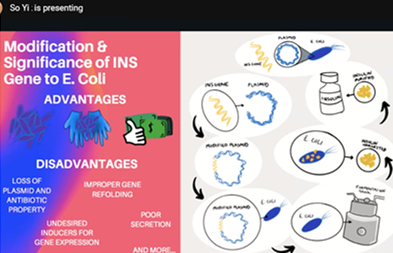
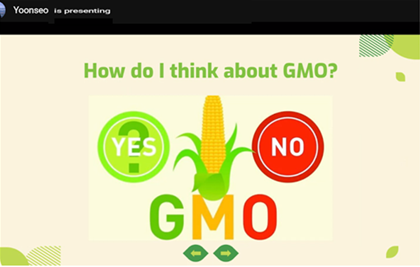
Grade 11 DP Biology
Grade 11 students were involved in setting up home based lab investigations.
The first one was, Estimating the Osmolarity of Potato cells. Students conducted the experiment at home, collected data, and have completed a detailed lab report.
Preparation: Chae Eun
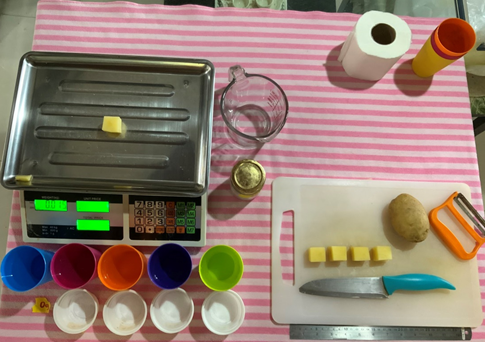
Preparation: Jaschia
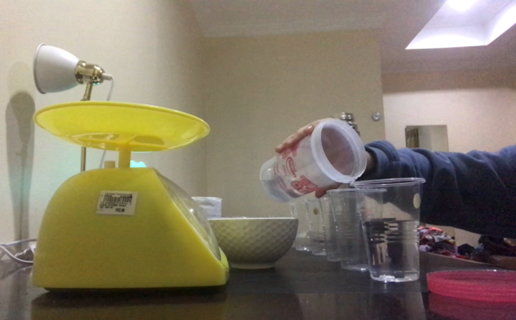
Set up – Pristina

Set up: Umi

Set up – Jenny
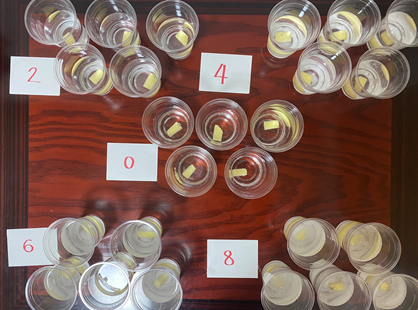
Preparing for data collection: Elena

Data collection: Kyoung Min

Data collection: Deandra
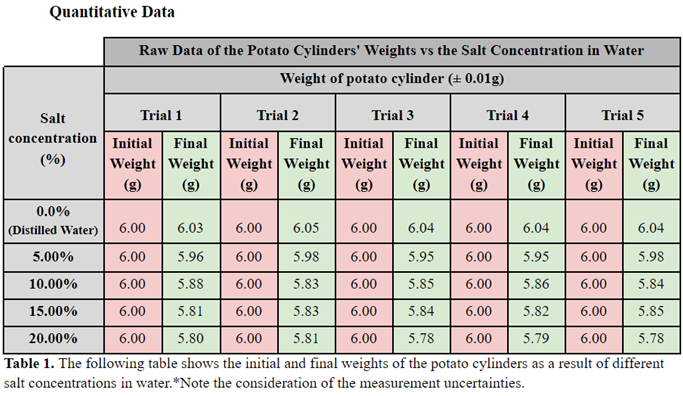
Visual representation of data: Deandra
Graph 1. Graph showing the effect of different salt concentrations on the average changes in mass (%).

Qualitative Data Collection: Deandra
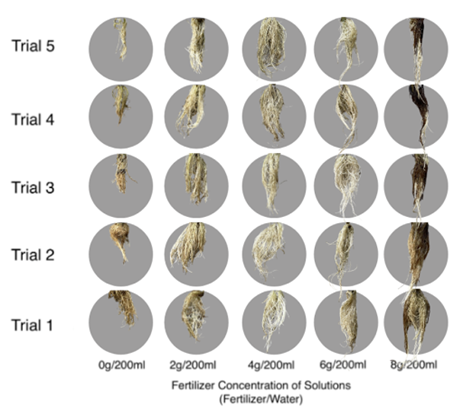
Set up: Luna
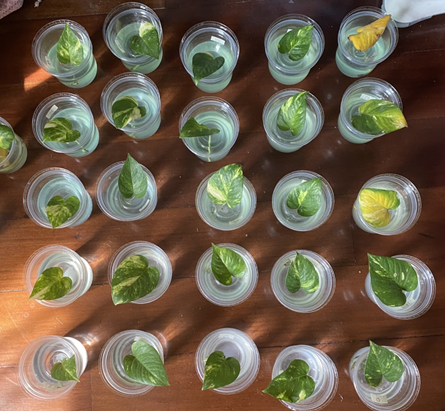
Preparation: Keenan
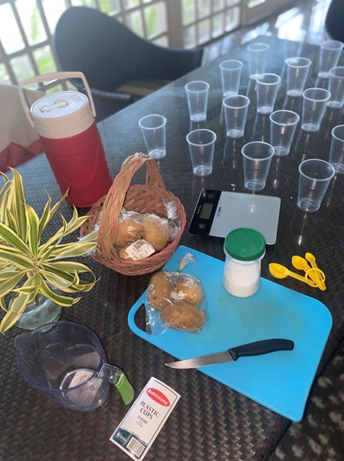
Set up – Jodi
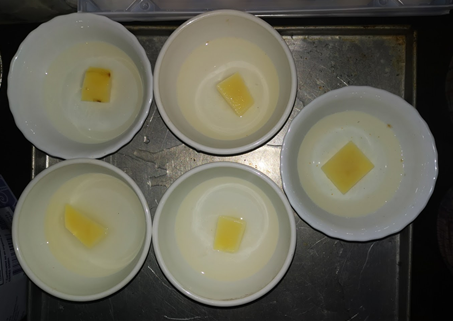
Set up – Luna

Preparing for data collection: Bianca

Qualitative data collection: Deandra

Visual representation of data: Jenny
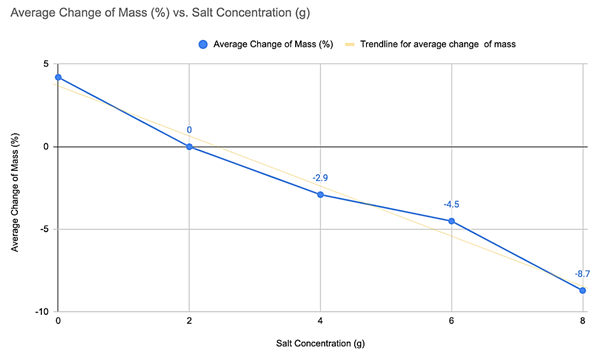
Visual representation of data: Sakura
Graph 1. Graph that shows the effect of different concentrations on the average change in mass (%).
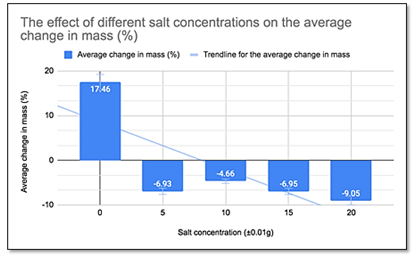
Investigation 2: Students are in the process of another investigation based on Factors that favour Cloning. Most students are in the experimental phase. A couple of them are already in the data collection phase as well.
Set up: Deandra
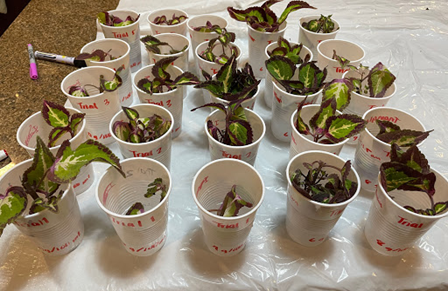
Set up: Chae Eun
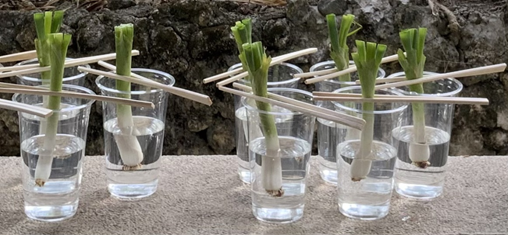
Set up: Sakura

Grade 12 Biology
Grade 12 students, after completing their IAs and mock exams, prepared and made a presentation on the topic, “Career Options in Biology”. The prompts provided were to choose their current favourite career option that is related to Biology, why they are interested in this career, and give an 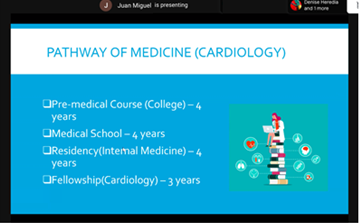 example of a person who is leading in this field and explore their failures and accomplishments. Students were also asked to identify further studies that may be required to pursue this career, and also the ways in which the IBDP program has helped them in laying the foundation for this career. Finally, students identified ways they could contribute to their local community and possibly on a global scale as well.
example of a person who is leading in this field and explore their failures and accomplishments. Students were also asked to identify further studies that may be required to pursue this career, and also the ways in which the IBDP program has helped them in laying the foundation for this career. Finally, students identified ways they could contribute to their local community and possibly on a global scale as well.
The students expressed themselves with passion about their interest in the following specialized fields that relate to careers in Biology. Here are a few examples:

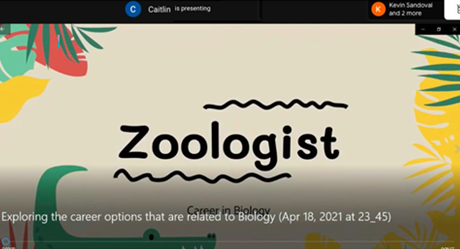


Grade 7 Science
May the force be with You!
Forces play a crucial role in our everyday lives. Force allows everything to fall into place. Scientifically speaking, force can cause a moving object to: accelerate, decelerate, change direction, and even change shape. With the help of force, people may also then be identified as powerful dynamos that create materials into something that is useful for them, if not improve the quality of our living. These past few weeks, the Grade 7 students have been busy putting together their understanding of non-contact forces such as: gravity, magnetism and electrical forces.
In a most creative way, they were able to cite how these three non-contact forces have affected their lives.
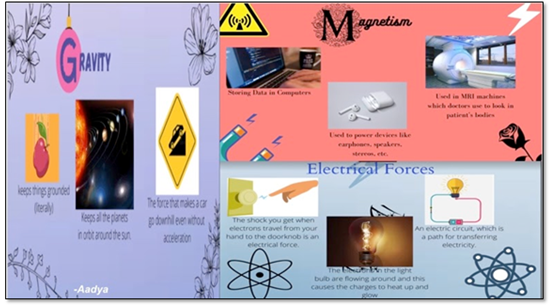
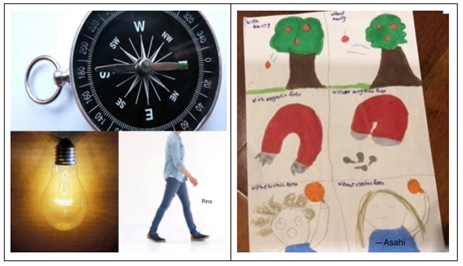
I fall
You fall
We all fall down
The force of gravity
Pulling us to the ground
You can never see it
It never makes a sound
It makes our mother earth
Go round and round and round
The planets have their orbits
Because of gravity
Pulls on flying objects
Pulls on you and me
Pulls on flying objects
Makes an apple fall
Lets up slip down slides
Makes a yo yo go.
—Xavier

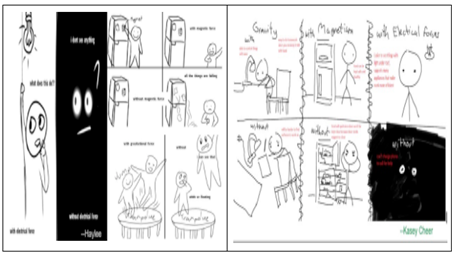
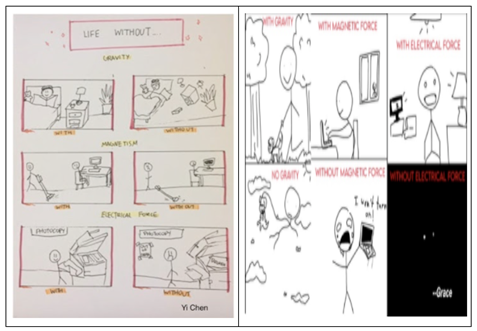
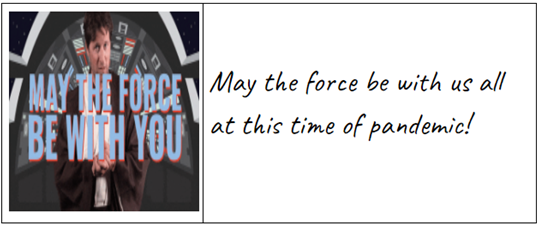 With these students’ reflections on the importance of force specifically the non-contact forces, it reminds me of the Star War’s famous line, “May the force be with you”. The speaker is saying that they wish the force to work in favour of the addressee, so he can do more. Although ‘May the force be with you’ obviously originates in science fiction, many use the phrase in everyday life, as it is seen as a nice way of saying goodbye, good luck, ‘may you be protected’ or ‘come back safely’. It was often used as people parted ways, or in the face of an upcoming challenge. The phrase originated in Star Wars: Episode IV A New Hope, and has continued to be a classic part of Star Wars stories ever since.
With these students’ reflections on the importance of force specifically the non-contact forces, it reminds me of the Star War’s famous line, “May the force be with you”. The speaker is saying that they wish the force to work in favour of the addressee, so he can do more. Although ‘May the force be with you’ obviously originates in science fiction, many use the phrase in everyday life, as it is seen as a nice way of saying goodbye, good luck, ‘may you be protected’ or ‘come back safely’. It was often used as people parted ways, or in the face of an upcoming challenge. The phrase originated in Star Wars: Episode IV A New Hope, and has continued to be a classic part of Star Wars stories ever since.
Grade 6 Science
Go Solar!
The sun is considered our main source of energy. It emits these photons (units of light energy) which are then absorbed by plants and are transformed into chemical energy, which then flows readily through a system. But this is not the end story of the sun’s energy transformation; in fact, it can be transformed into power– an electricity that lights every household on the planet.
The Grade 6 students are hooked into understanding the important considerations for the most appropriate ways solar panels will be installed at homes. These include seasonality, tilt, azimuth and shade. It’s a good investment to avail of the sun’s energy–because no one owns it.
In need of any Solar Power information? –Call the Grade 6 students. They have a lot to say…

This type of energy resource is said to be renewable, and poses less harm to the environment–thus a cry to GO SOLAR! is the motto of the Grade 6 students.
Here’s a piece of their brilliant thoughts that might help change our perspectives and avail of the solar power that is already available in the market.
“Solar power is the last energy resource that isn’t owned yet – nobody taxes the sun yet.” – Bonnie Rait
So, what are we waiting for?—Let’s Go Solar!
CIS Esports Club
by Mr. Ace Pierra, Athletics Director
The CIS Valorant team has worked hard throughout the past months to be able to compete with other schools. In fact, a few players in the CIS Valorant team have reached the top 11% of global players in Valorant which has 3 million daily players. Valorant is a tactical team based shooter in which team coordination is the key to winning games. Throughout the past weeks the CIS Esports Club has had friendly scrimmages with Faith International Academy. While the results were not what we would have hoped for, the CIS team was able to learn a lot and bond together as a team and also with the FIA students. The CIS Esports Club had also made a new set of friends that they can collaborate with. Further along the club’s life we hope to see more support and even be able to establish a streaming system in which you guys can watch and support us from the comfort of your own computers. We also hope to be able to continue this ASA for the next school year.


Media Center News
Dear Students and Families,
We are now in our few weeks before the school year ends. The library/Media center would like to inform you that you may now return the books that you currently checked out before May 28th. You may return the books to the main office, with Ms. Lory. If you wish to keep the books over the summer, please send an email to Mr. Monfre (dmonfre@cis.edu.ph ) or Ms. MJ (mcordova@cis.edu.ph ) and attach a photo of the books. You can also borrow books for the summer and send your requests in the first week of June. Please be informed that the turnaround time of the books that you’ll be checking out for the summer can be delayed due to COVID restrictions.
If you have any questions, please feel free to reach out to any of the Library/Media Center Staff Mr. Monfre (dmonfre@cis.edu.ph) and Ms. MJ (mcordova@cis.edu.ph).
Dragon’s Print
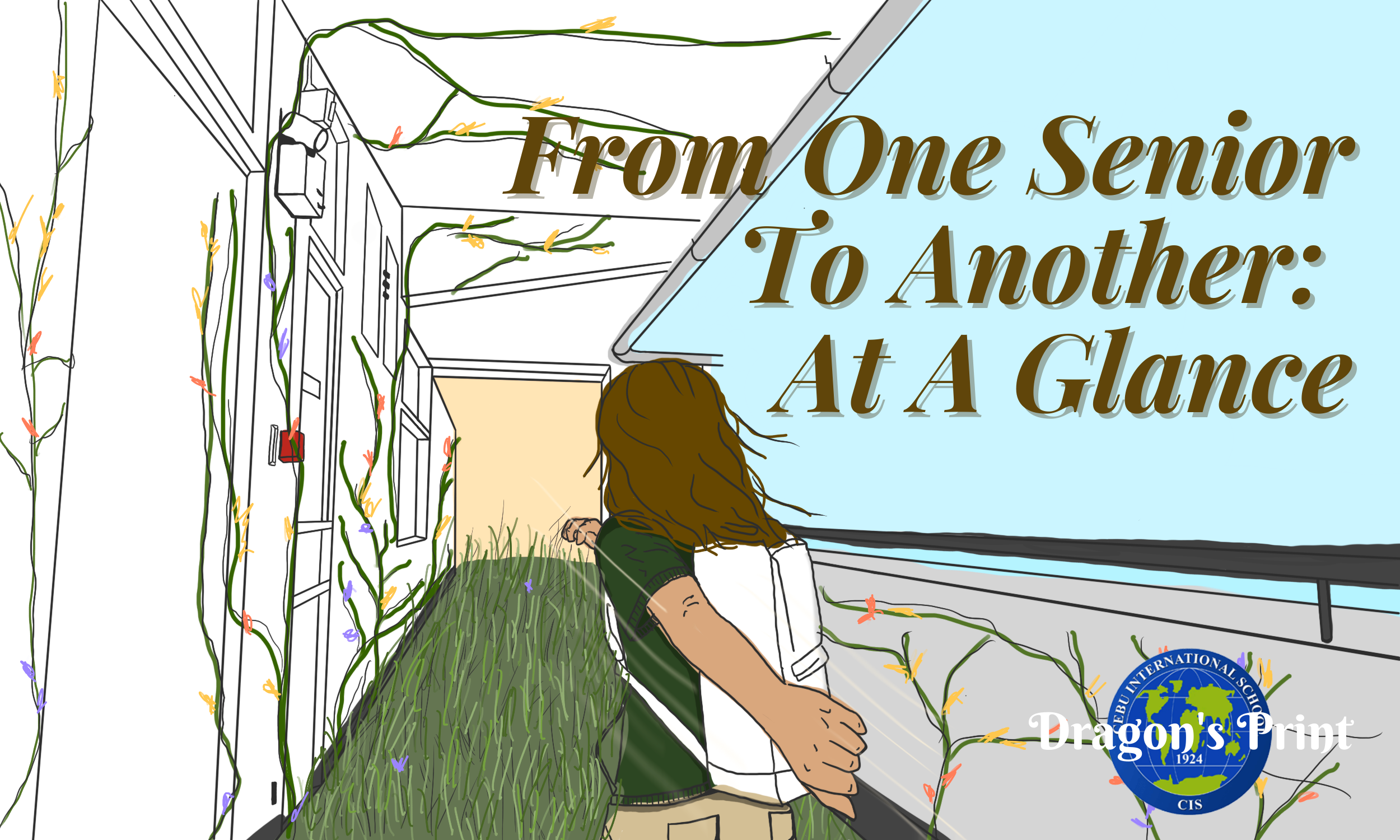
As the school year finally comes to a close, here is twelfth-grader Venise T. as she reminisces the journey of Class of 2021 in their last year of high school. Read more at https://dragonsprint.cis.edu.
College/Careers Counselor Corner
by Ms. Jenny Basa, College/Careers Counselor Corner
Scholarships in the USA: “Where can I find them?
One of the challenges of studying abroad is to finance your education. If you need a scholarship to attend an institution, check the website to see if the university offers scholarships. There is usually a wide range of scholarships and eligibility to these grants are indicated. In addition, here are a few websites you can check:
Upcoming Virtual Events and Fairs: (students & parents are welcome)
DATE
May 15 Saturday
11:30 AM – 3:00 PM
EVENT (IDP Webinar Series)
Canada Virtual Fair
Institutions from British Columbia, Alberta, Manitoba and Saskatchewan
LINK to register & view participating schools
May 16, Sunday
11:30 AM – 3:00 PM
Canada Virtual Fair
Institutions from Ontario, Quebec and Atlantic Canada
LINK to register & view participating schools
May 18 Tuesday
6:30PM
May 22 & 23
Saturday & Sunday
1:30 PM – 5:00 PM
May 29 Saturday
3:30PM – 7:00 PM
